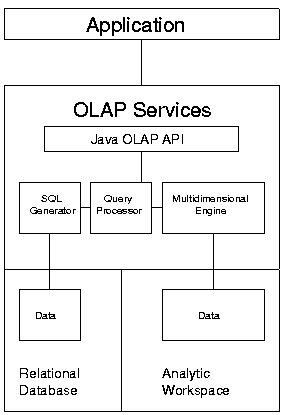Release 1 (9.0.1)
Part Number A86720-01
Home |
Book List |
Contents |
Index | Master Index | Feedback |
| Oracle9i OLAP Services Developer's Guide to the OLAP DML Release 1 (9.0.1) Part Number A86720-01 |
|
Basic Concepts, 2 of 5
The OLAP DML is a data manipulation language. You can use DML commands and functions to perform complex analysis of data. You can also write programs that contain DML commands and functions.
If you are familiar with Oracle Express Server, think of the OLAP DML as being the same as the Express Server stored procedure language (SPL). In fact, the OLAP DML is nearly 100 percent compatible with Oracle Express Server's stored procedure language.
The basic syntactic units of the OLAP DML are:
OLAP DML commands, functions, and options are collectively referred to as commands. The complete syntax for each command is provided in the OLAP DML Reference, which is a help system that you can access from OLAP Worksheet.
The purpose of the OLAP DML is to allow application developers to extend Oracle OLAP Services' Java OLAP API.
To describe the purpose of the OLAP DML, it is important to discuss a few important concepts such as:
OLAP Services can access two different data sources -- the Oracle relational database and analytic workspaces. For most applications the Oracle relational database will be the primary (and often the only) data source. When accessing data from the Oracle relational database, OLAP Services generates SQL to access data stored in tables. The OLAP API provides a wide variety of analytic functions that allow the application to derive calculated measures when using the Oracle database as the data source.
In some cases, however, the OLAP API does not provide the means to calculate data needed by an application. Examples include forecasts, solving a model, some types of consolidations (aggregations), and allocations. In this case, you can use the OLAP DML to calculate this data. The OLAP DML does not operate directly on data in relational tables. Instead, it operates on data within an analytic workspace.
An analytic workspace is a multidimensional data source. It may be temporary (that is, for the life of the session) or it may be persistent. When an analytic workspace is persisted, a separate data file is created that is not part of the relational database.
The OLAP API performs three primary functions:
When accessing data in the relational database, OLAP Services processes OLAP API queries by generating SQL. When accessing data in an analytic workspace, OLAP Services processes OLAP API queries by using OLAP Services' multidimensional engine and the OLAP DML.
The following illustration provides an architectural overview of OLAP Services, showing both the relational database and analytic workspaces as data sources.

|
|
 Copyright © 1996-2001, Oracle Corporation. All Rights Reserved. |
|